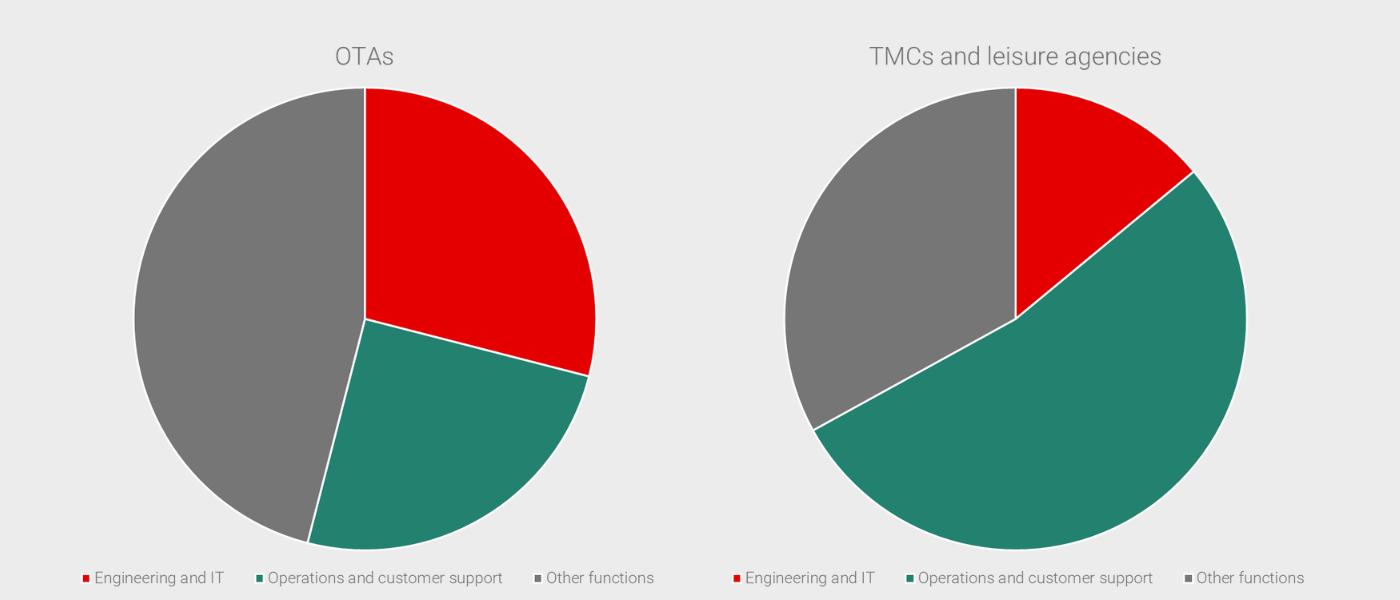Developing modern online travel retailing experiences is a juggling act between laying strong tech foundations, introducing new capabilities, managing technical debt, and responding to competitor offerings. But you can get thrown off balance when business expectations stretch technical feasibility.
To set yourself up for success, you need to bridge the divide with stronger cross-department communication and the right technology partner. Let’s explore some collaboration tactics and consider how engineering leaders can improve technical capabilities with Sabre’s support.
Managing the mismatch: business expectations vs technical reality
How often have you heard these questions or similar…
Our competitor just released new capabilities. Can you replicate ASAP?
We need to embed AI/ML into our app. How soon can you do it?
Conversion rates are down this month. Can you do something quickly to improve them?
This process is too expensive. Can you automate it?
There’s a perennial divide between leaders across organizations: engineering and operations, sales and customer support, marketing and finance. This is often caused by competing priorities, communication gaps, resource constraints, and a misalignment between long-term goals and short-term wins.
Each of these is compounded by an underestimation of technical complexity. When you’re busy creating seamless customer experiences, building a lightning-fast travel search, integrating new suppliers, and optimizing complex mid and back-office processes, the last thing you want to hear is an unexpected ask or pivot in business strategy that doesn’t consider the feasibility of new projects.
Resilience is a core pillar of high-performing engineering teams. But this doesn’t negate the impact of turbulence created by the disconnect between business expectations and technical realities, leading you to feel frustrated and protective over your team and their workload.
There’s growing pressure to get ‘modern’
Online travel agencies (OTAs) already deliver some of the most intuitive, frictionless experiences in the industry. But as an engineering leader, you’re always challenged to deliver more. Business leaders want more conversions, revenue, competitive differentiators, process automation, and cost efficiencies. Customers want more personalization, flexibility, self-service capabilities, and travel content.
There’s good news – these are some of the promises of the industry-wide transition to ‘modern retailing’, enabled through New Distribution Capability (NDC), ONE Order and the broader offer and order construct. However, the race is on and your competitors are already implementing and experimenting with these data standards and AI/ML solutions to deliver new products, personalized offers, and streamlined processes, and richer experiences. The asks of your engineering team aren’t going anywhere; they may even increase as pressure mounts for you to stay competitive.
Engineering teams are more important than ever
The ability to modernize travel experiences at pace is predicated on OTAs having the best people as well as the best technology. In the last decade, technical teams have ballooned in size notably driven by a hiring surge during the pandemic. Despite recent global economic pressures impacting organizations across the industry, OTAs still lead the travel industry with large tech teams, bolstered by the need to deliver frictionless online web and mobile experiences at scale.

Looking at fifteen leading OTAs, their engineering and IT departments make up an average of 29% of the employee base compared to 14% for travel management companies (TMCs) and traditional leisure agencies. The inverse is true for operations and customer support at 25% and 53% respectively where OTAs lead the industry with do-it-yourself servicing capabilities.
But having a large tech team doesn’t automatically equal success. The next step is to enable engineers to do their best work and limit the disruption caused by unachievable requests from non-technical business leaders.
Five tips for better alignment with non-technical leaders
As a global technology provider to the travel industry and an organization with a large proportion of engineering talent, we recognize the importance of ambitious and achievable technical strategies aligned with business objectives.
As modern retailing becomes a reality, we’re entering a period of uncertainty as the knock-on effects on systems and processes are still emerging. Going back to basics can help you work fast and effectively set and manage expectations. Here are some of the collaboration tactics that are undoubtedly part of every tech leader’s toolkit that continue to work well for Sabre teams.
Agree on business goals that align with feasible technical solutions
Set yourself up for success. It’s important to make sure other business units’ goals aren’t dependent on unachievable tech deliverables. Share your goals with business leaders, critically assess their objectives to understand how engineering work will influence results and push back on unrealistic targets. An example of an unrealistic goal could be revenue generated primarily through launching multiple new products without end-to-end workflow support.
Present engineering successes linked to business impact
Showcase your achievements. Presenting engineering successes that directly correlate to business outcomes will help you demonstrate how your team contributes to wider business efforts. By quantifying the results, you can garner appreciation and support in terms that matter to non-technical business leaders. Examples include new travel content and revenue growth, reduced user friction and customer retention, process automation and cost savings, website speed and conversions.
Educate business leaders on technical complexities and development processes
Collaborate with transparency. Although business leaders don’t need to know all the technical intricacies involved in product development and maintenance, a baseline knowledge is beneficial. Conducting workshops, sharing informative documents without jargon, and hosting knowledge-sharing sessions can help business leaders grasp the complexities. Examples include simplified diagrams of system interactions, supplier connectivity, and data flows.
Illustrate examples of innovation grounded in reality
Get other leaders excited. Engineering is a never-ending balance between building and maintaining core systems while experimenting with new technologies to push the business forward. Share examples of innovations to show business opportunities, for example, new ways to embed AI into the user experience to improve conversion rates. But ground these examples with what could be delivered in a realistic time frame based on competing priorities and existing roadmaps.
Communicate what you need from other leaders and what you can give them
Ask for what you need. Time, money, information, resources, training, support, feedback, updates – the list goes on. Take time to figure out what your engineering team needs to succeed and communicate that with other business leaders. But also let leaders across the business know how you can support them to achieve their goals, whether through project status updates, technical feasibility assessments, cross-functional development workshops, risk mitigation planning sessions, or scalability and performance considerations for new product ideas.
“Change may be constant, but that doesn’t make it easy. The reality of leading engineering teams is that you’ll often be asked to keep moving in the face of that change; features still need to be written, bugs need to be fixed, systems need to keep running. Accomplishing that requires a clear recognition that humans are doing this work, not machines. And, as it turns out, humans are far better at adapting to change when they can lean on others.”
–Laurie Barth in An engineering leader’s guide to tackling change
You can’t do it alone: Sabre is your technology partner
Effective communication with your non-technical counterparts is only one piece of the puzzle. The other is increasing technical capabilities altogether, made more difficult with the looming tech talent shortage persisting in areas like cloud computing and emerging in areas like artificial intelligence. That’s why choosing the right technology partner is crucial.
As a tech provider chosen by the world’s leading online travel sellers, we deeply understand the technical needs and opportunities that matter to you. Engineering leaders at OTAs choose to work with us to focus on their core business, access AI/ML capabilities powered by Google, dramatically reduce the cost of servicing, and more.
- Focus on your core business: As travel content becomes more fragmented, we’re building an intelligent multi-source travel platform to do the heavy lifting of aggregation and normalization for you. You can reallocate engineering investment on growth and customer experiences and go to market with new capabilities faster instead of keeping up with the evolving technical considerations of multi-source content distribution and retailing.
- Access AI/ML capabilities powered by Google: Artificial intelligence and machine learning are quickly becoming table stakes for businesses and OTAs are no exception. We’ve partnered with Google in a 10-year strategic initiative to help you scale retailing and operations with a cloud technology platform and advanced AI/ML tools and capabilities. You can combine your in-house expertise with ours, enhanced with Sabre’s extensive industry data and powered by Google tools including Vertex AI, to deliver highly relevant and personalized experiences. These unlock revenue and conversion opportunities, helping you meet business goals with less manual work.
- Dramatically reduce the cost of servicing: Post-booking automation is critical for an exceptional customer experience. You can lower the cost of servicing and improve customer satisfaction with streamlined workflows and self-service capabilities by integrating our effective automation solutions. You’ll also save on costly and time-intensive technical maintenance needed to keep up with changing data and content types, supplier APIs, and workflows.
Moving forward
In your role as an engineering leader, you’re responsible for delivering modern retailing capabilities and collaborating with non-technical leaders to set realistic strategic objectives. Improving communication with your leadership colleagues and choosing the right technology partner can help you close the gap between business expectations and technical feasibility. Why not get in touch and let’s explore together how we can set your team and organization up for success.
Stay in touch
Fill out the form below and be the first to know when we release new blogs.

